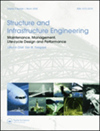Structure & Infrastructure Engineering- Maintenance, Management and Life-Cycle Design & Performance is an international journal dedicated to recent advances in maintenance, management and life-cycle performance of a wide range of infrastructures such as: buildings, bridges, dams, underground constructions, offshore platforms, pipelines, naval vessels, ocean structures, nuclear power plants, airplanes and other types of structures including aerospace and automotive structures. The aim of this journal is to present research and developments on the most advanced technologies for analyzing, predicting and optimizing infrastructure performance. The main gaps to be filled are those between researchers and practitioners in maintenance, management and life-cycle performance of infrastructure systems and those between professionals working on different types of infrastructures. To this end, the journal will provide a forum for a broad blend of scientific, technical and practical papers. Papers considered for publication are original, high-quality papers that form: a significant contribution to the theory or practice of infrastructure engineering, or: a state-of-the-art work on a topic related to infrastructure, or: a case study of application of theory to a significant infrastructure problem. The scope of the journal encompasses, but is not restricted to, mathematical modelling, computer and experimental methods, practical infrastructure applications in the areas of assessment and evaluation, construction and design for durability, decision making, deterioration modelling and aging, failure analysis, field testing, financial planning, inspection and diagnostics, life-cycle analysis and prediction, loads, maintenance strategies, management systems, non-destructive testing, optimization of maintenance and management, specifications and codes, time- dependent performance, rehabilitation, repair, replacement, reliability and risk management, service life prediction, strengthening and whole life costing.
